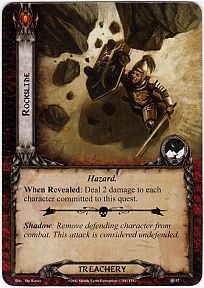

Rockfalls occur in mountainous
areas, especially in places
where a deep valley separates two sharply rising peaks. They are
most likely in areas where the rock faces contain a large number
of cracks and outcroppings, and during the time of year when the
temperature fluctuates between freezing at night and well above
freezing during the day. Water accumulates in the cracks and
small openings between different layers of rock; every time the
water freezes it expands in volume and drives the two rock
masses slightly farther apart. When the crack widens and
lenghtens sufficiently, one of the rock masses breaks away from
the other and falls.
Some areas are relatively more prone to rockfalls
because of
the composition of the rocks themselves. If the face of a cliff or
the sloping side of a mountain is made up of rocks that crumble or
fracture easily, the same area can produce a rockfall of significant
proportions as often as once every two months. If the ground
at the base of a cliff or a mountainside is strewn with chunks of
loose rock, this is a sure indication that the area is one where
rockfalls are common.
If a character is caught in a rockfall on the slope
of a mountain,
he will be “attacked” 4 times per round for a duration of 2-5
rounds (1 d4 + 1) by rocks of sufficient size to do him harm. Each
rock has the same chance to hit as a monster of 5 hit dice, and
those that hit will cause ld4 points of damage apiece. A character
who makes a successful Dexterity Check will take only half
damage from each rock that hits him (reflecting his ability to
move and take the blows on less vital areas of his body), but any
rock that hits will do at least 1 point of damage. If a character
takes more than 20 points of damage from the rolling rocks, he is
knocked off his feet and swept down the slope so that he also suffers
abrasion damage and impact damage from the tumble.
A character climbing a cliff when a rockfall occurs
can protect
himself quite well by holding a shield over his head with both
hands. There is a 75% chance that any rock that would have otherwise
hit the character (see below) will hit the shield instead.
However, a character can only use this tactic if he has the free
use of both hands, is carrying a shield, and has time to get it into
position before he is hit. It takes one round to unstrap a shield
from one’s back, or one-half round to unfasten a shield being carried
on one’s belt. A rockfall coming down a vertical or nearvertical
cliff face will last for 1-2 rounds, during which time each
character in its path will be “attacked” by 0-3 rocks per round,
each one striking as a monster of 7 hit dice. (If characters had a
chance to notice rocks at the base of the cliff and climbed it anyway,
roll 1d4 and subtract 1 to get a number in the appropriate
range. If they had no reason or opportunity to anticipate the rockfall
before they began climbing, roll ld6 and subtract 3.) Each
rock that hits will do ld6 points of damage. After any damage roll
of 3 or more, the victim must make a Climbing Check to avoid being
knocked from his perch. A damage roll of 5 or 6 indicates that
the character’s head has been hit, and if a character sustains two
hits on the head he is knocked unconscious. This will certainly
cause him to fall unless he is in a very stable position (such as on
a wide ledge) or fastened to the cliff face.
A character standing at the base of a cliff when
a rockfall occurs
is subject to all the dangers that threaten someone climbing
a cliff, except that he has no chance of falling, each rock strikes
as a monster of 10 hit dice, and the damage from each rock that
hits him is ld8 instead of ld6. A damage roll of 5 or more indicates
a hit on the head, and if a character receives two such
blows he will fall to the ground unconscious, making him more
likely to be hit by rocks that have yet to come down.
| Natural Hazards in the Wilderness | WSG |